Esula, SpurgeTithymalus, Xencua |

|

|
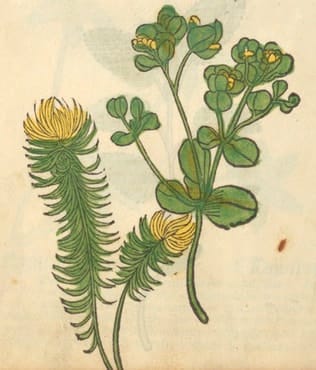 2 types of Esula
2 types of EsulaGart der Gesundheit, Cuba, 1485
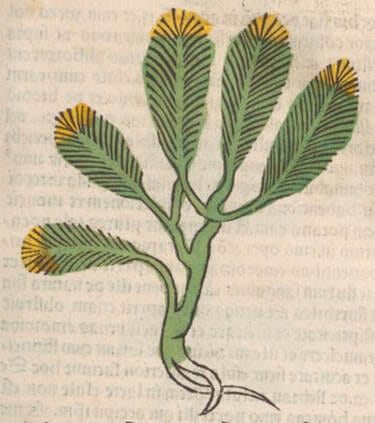 Herbarius latinus, Petri, 1485
Herbarius latinus, Petri, 1485 |
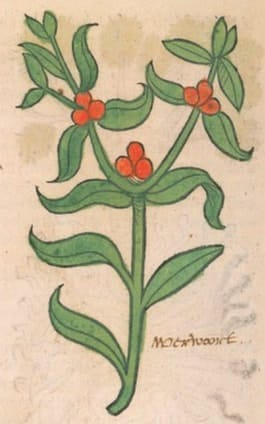 Ortus Sanitatis, Meydenbach, 1491
Ortus Sanitatis, Meydenbach, 1491 |
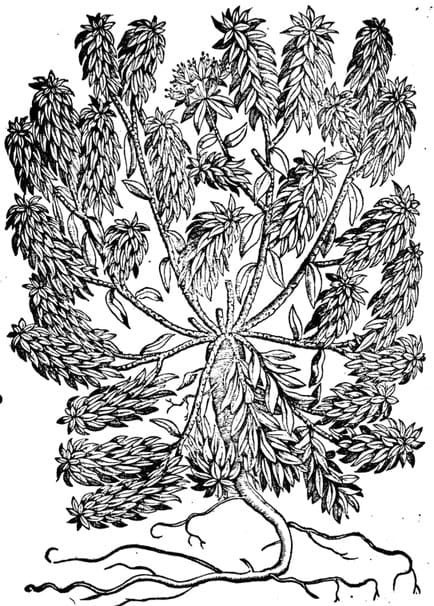
|
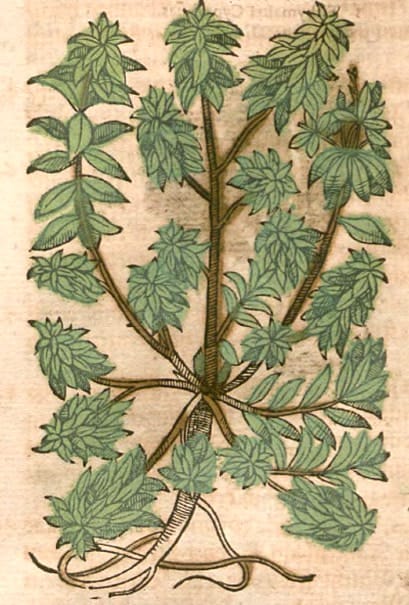
|
|
Esula New Kreuterbuch, Matthiolus, 1563 |
Greater Spurge; Esula Major Krauterbuch, Lonitzer, 1578 |
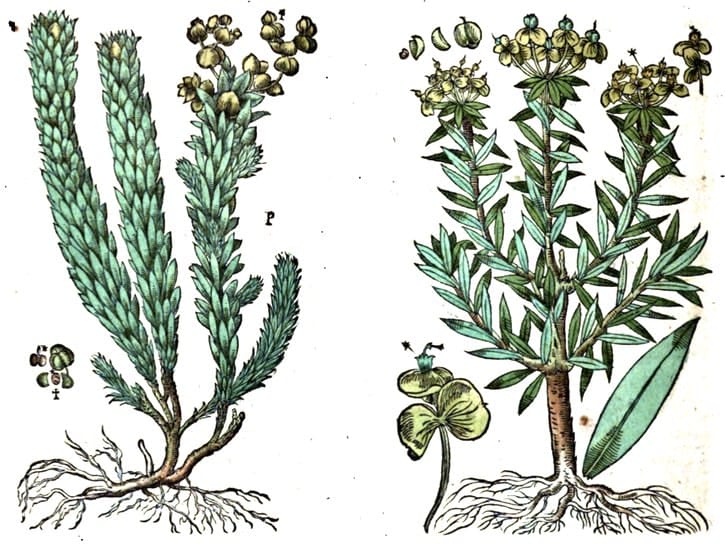 Left: Tithymalus Paralius, Right: Tithylamus Dendroides
Left: Tithymalus Paralius, Right: Tithylamus DendroidesKreutterbuch, Matthiolus, 1586
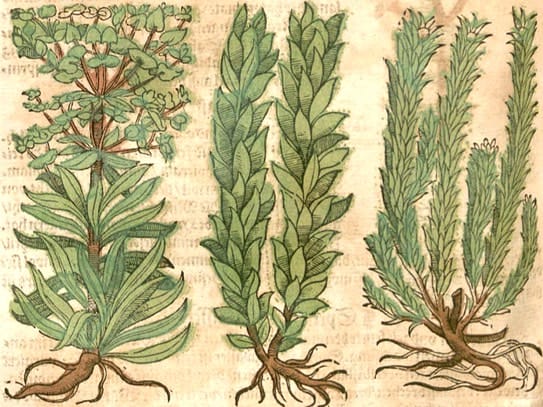 Various species of spurge
Various species of spurge(left) Tithylamus characias or ‘male’; (center) T. mirsinites or ‘female’; (right): T. paralius or Esula Marina
Krauterbuch, Lonitzer, 1578
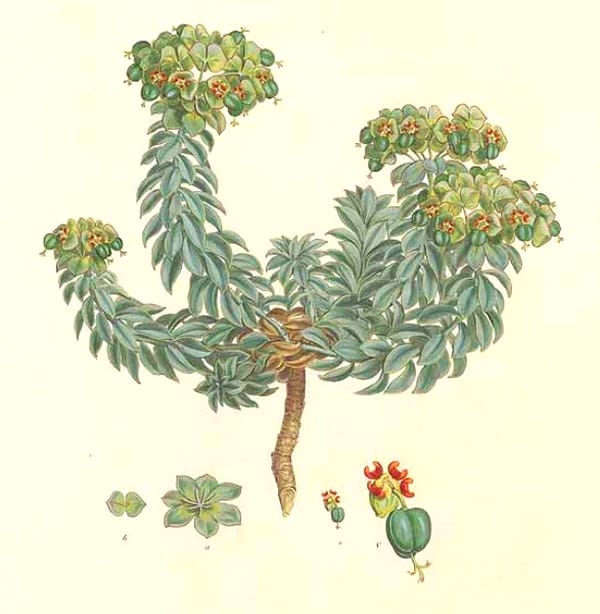 Euphorbia myrsinites
Euphorbia myrsinitesJ. Sibthrop, J.E. Smith, Flora Graeca, vol. 5 (1825)
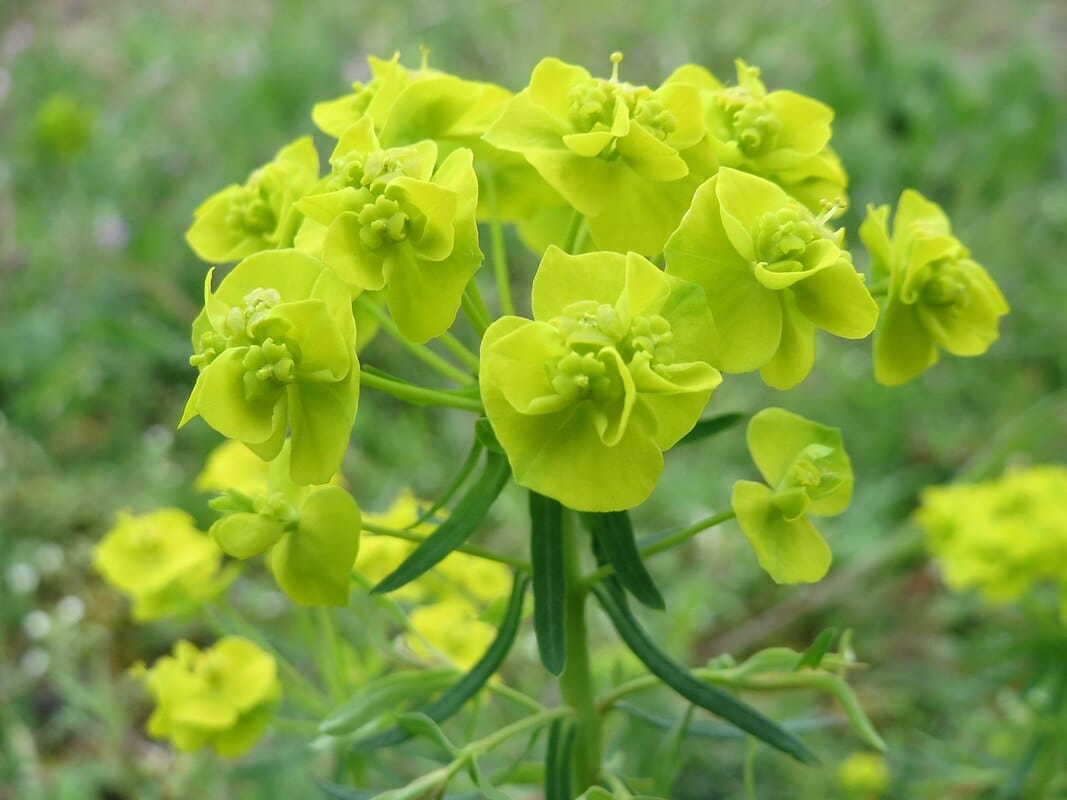 Euphorbia cyparissias
Euphorbia cyparissias(Photo by AnRo0002) (Wikimedia) |
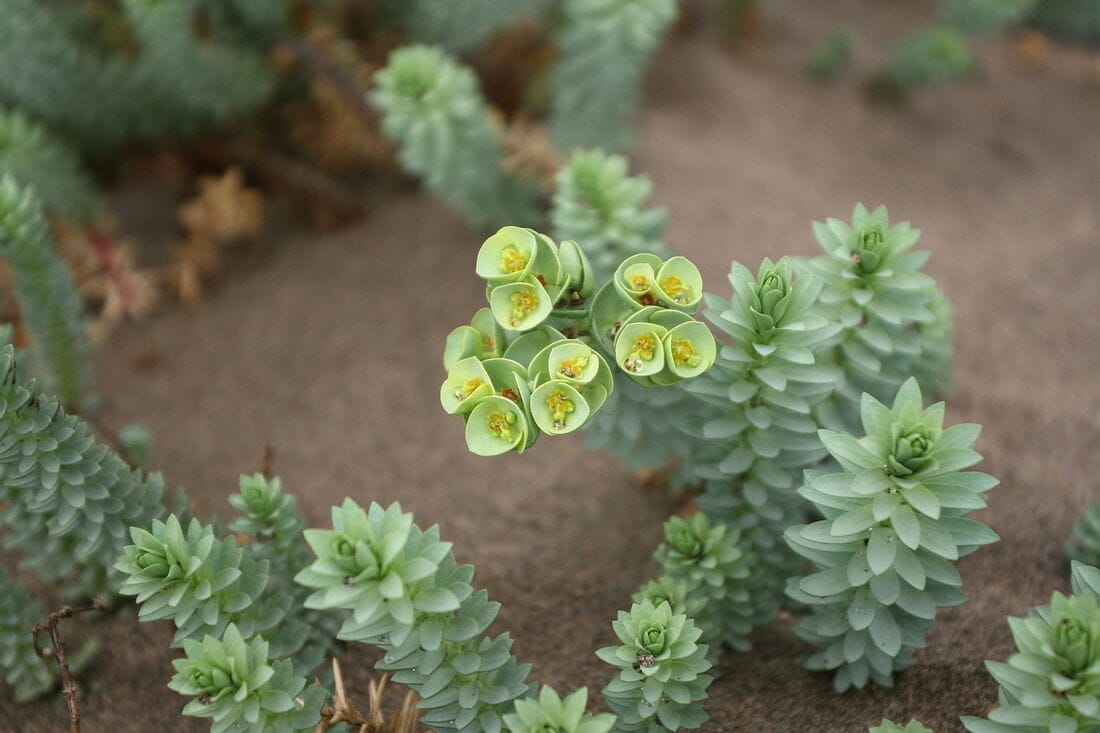 Euphorbia paralias
Euphorbia paralias(Photo by Frank Vincentz) (Wikimedia) |
Botanical name:
Euphorbia spp.
A number of species have been used:
- E. cyparissias (syn. Euphorbia Tithymalus, Esula Minor, Tithymalus Cyparissiae, Cupressini officinalis)
- E. myrsinites (Caryites, Myrtites)
- E. paralias (Paralios, Tithymalis., Sea Spurge)
- E. helioscopia (Helioscopios)
- E. characias (Characias, Red Spurge)
- E. platyphyllos (Platyphyllos, Corymbites, Amygdalites, Broad-Leaf Spurge)
- E. dendroides (Dendroides, Cobios, Leptophyllos, Shrubby Spurge)
- E. lathyris (Caper Spurge, Qian Jin Zi) (Seed is used)
TCM uses 2 closely related species which are also drastic cathartics, and whose roots are likewise prepared with Vinegar.
Parts used:
Prepared Root-Bark
Temperature & Taste:
Hot, dry. Pungent, very disagreeable taste. Toxic
sharp, fiery, corroding
Uses:
1. Clears Cold-Phlegm and Purges Water:
-Strongly clears Phlegm and Water
-serious Edema, Ascites
-can be used externally. over the abdomen to purge water
2. Clears Wind-Damp:
-Arthritic and Rheumatic complaints
-all types of ‘Pocky distempers’.
-also Venereal diseases
3. Kills Worms
4. Emetic:
-Seed has been used as an Emetic
5. Externally:
-milky juice is applied to Warts, Corns and other skin growths
-juice is effective if applied to Basal Cell Carcinoma
–useful as an oil for atrophic and paralyzed extremities
-used for Hemorrhoids
Dose:
Prepared Root-bark: 500–1500mg (traditionally 1 scruple–1 dram [1200mg–3.8 grams]) in Hydromel.
Preparation:
1. Root bark is steeped in Vinegar for 3 days, then dried for use. In addition, some recommended using only after it has been stored a year.
2. Leaves steeped in vinegar and dried and powdered were also used.
3. The juice can be mixed with Sugar of Roses or of Violet into a paste. (The English Unparalleled Physician, Border, 1651)
Substitutes:
1. The related Chinese Euphorbia pekinensis Da Ji and Euphorbia kansui Gan Sui. can be used in place of Esula.
Correctives:
1. Bdellium, Tragacanth, Mucilage, Purslane juice (to help mitigate its burning, fiery quality)
2. Spikenard, Cinnamon, Nutmeg
3. Nightshade, Endive, Purslane, Quince seed
4. Mastic
Main Combinations:
1. To purge in Phlegm and Damp disorders, it was regularly combined with a little Colocynth, Colchicum, or Daphne Mezereon, with milder purgatives such as Aloe or Senna, warming medicines to activate them, such as Cinnamon, Clove, Cardamon, Indian Spikenard, and some correctives such as Mastic, Tragacanth and Marshmallow.
i. in Wind-Phlegm diseases of the head, Orris, Calamus, Stoechas or Peony can be added
2. Edema from Cold and Damp:
i. Prepared Esula (5 scruples), Cinnamon, Fennel seed, Aniseed, Mastic (each 6 grains). Make a powder (Pemell, 1652)
ii. Prepared Esula, Yellow Myrobalan (4 parts each), Aloes (5 parts), make a pill mass with Fennel or Endive juice. Dose: 1–2 drams (Pemell, 1652)
iii. Prepared Esula, Aniseed, Citrol peel, Cinnamon, Mint (Pemell, 1652)
iv. Prepared Esula prepared and powdered half dram, form a potion with Fennel juice (1 oz.), White Wine (3 oz.) (Pemell, 1652)
v. Prepared Esula, Parsley root, Dwarf Elder, Acorus (1 oz. each), Fennel seed, Celery seed, Aniseed (2 drams each), Mastic, Cinnamon (1 dram each). Decoct, add sugar and form a syrup (Herbarius latinus, Petri, 1485)
3. Scrofula, Lymphatic swellings, Phlegm Tumors
i. Prepared Esula with Asparagus root, Figwort root, Polypody, Orris, Calamus, Cumin (as in Wine for Scrophula)
ii. Wind-Phlegm Scrofula and Masses, prepared Esula with Dodder, Polypody, Agaric, prepared Black Hellebore
4. Melancholy, Fear, Prepared Esula with Black Myrobalan, Polypody, Dodder, Agaric, prepared Black Hellebore, Clove, Balm (as in Electuary for Melancholy and Fear of Filius Zacharia)
5. Wind-Phlegm Epilepsy, Dizziness, Headache and Wind-Damp Joint pain, Prepared Esula with Aloe, Turbith, Gum Ammoniac, Chebulic Myrobalan, Scammony, Agaric, Euphorbium, Cinnamon, Saffron, Cardamon (as in Foetid Pills Major of Galen)
Major Formulas:
Wine for Scrophula (Renodeus)
Electuary for Melancholy and Fear of Filius Zacharia
Foetid Pills Major of Galen
Cautions:
1. Very irritating. Dangerous for internal use. Only used in compound and only in cases with serious Cold Phlegm or Water obstruction. Only used in strong individuals.
2. Avoid in Pregnancy.
3. Very drying; ‘It spoils the body, and makes it dry’ (Lonicerus)
Antidotes:
1. Armenian Earth, Sealed Earth
2. Red Coral
3. prepared Deer Horn
4. Theriac with wine, or Water of blessed Thistle
5. Gum Arabic and Tra∣gacanth
Main Preparations used:
Prepared root-bark
-
Extra Info
-
History
|
‘The tithymalos is called by our people the “milk plant,” and by some persons the “goat lettuce.” They say, that if characters are traced upon the body with the milky juice of this plant, and powdered with ashes, .when dry, the letters will be perfectly visible; an expedient which has been adopted before now by intriguers, for the purpose of communicating with their mistresses, in preference to a correspondence by letter. There are numerous varieties of this plant. The first kind has the additional name of “characias,” and is generally looked upon as the male plant. Its branches are about a finger in thickness, red and full of juice, five or six in number, and a cubit in length. The leaves near the root are almost exactly those of the olive, and the extremity of the stem is surmounted with a tuft like that of the bulrush: it is found growing in rugged localities near the sea-shore. The seed is gathered in autumn, together with the tufts, and after being dried in the sun, is beaten out and put by for keeping. ‘As to the juice, the moment the down begins to appear upon the fruit, the branches are broken off and the juice of them is received upon either meal of fitches or else figs, and left to dry therewith. Five drops are as much as each fig ought to receive; and the story is, that if a dropsical patient eats one of these figs he will have as many motions as the fig has received drops. While the juice is being collected, due care must be taken not to let it touch the eyes. From the leaves, pounded, a juice is also extracted, but not of so useful a nature as the other kind: a decoction, too, is made from the branches. ‘The seed also is used, being boiled with honey and made up into purgative pills. These seeds are sometimes inserted in hollow teeth with wax: the teeth are rinsed too, with a decoction of the root in wine or oil. The juice is used externally for lichens, and is taken internally both as an emetic and to promote alvine evacuation: in other respects, it is prejudicial to the stomach. Taken in drink, with the addition of salt, it carries off pituitous humours; and in combination with saltpetre, removes bile. In cases where it is desirable that it should purge by stool, it is taken with oxycrate, but where it is wanted to act as an emetic, with raisin wine or hydromel; three oboli being a middling dose. The best method, however, of using it, is to eat tho prepared figs above-mentioned, just after taking food. In taste, it is slightly burning to the throat; indeed it is of so heating a nature, that, applied externally by itself, it raises blisters on the flesh, like those caused by the action of fire. Hence it is that it is sometimes employed as a cautery. ‘A second kind of tithymalos is called “myrtites” [Euphorbia myrsinites] by some persons, and “caryites” by others. It has leaves like those of myrtle, pointed and prickly, but with a softer surface, and grows, like the one already mentioned, in rugged soils. The tufted heads of it are gathered just as barley is beginning to swell in the ear, and, after being left for nine days in the shade, are thoroughly dried in the sun. The fruit does not ripen all at once, some, indeed, |
not till the ensuing year. The name given to this fruit is the “nut,” whence the Greek appellation “caryites.” It is gathered at harvest, and is washed and dried, being given with twice the quantity of black poppy, in doses of one acetabulum in all. ‘As an emetic, this kind is not so efficacious as the preceding one, and, indeed, the same may be said of all the others. Some physicians recommend the leaf to be taken in the manner already mentioned, but say that the nut should either be taken in honied wine or raisin wine, or else with sesame. It carries off pituitous humours and bile by stool, and is curative of ulcerations of the mouth. For corrosive sores of the mouth, the leaf is eaten with honey. ‘A third kind of tithymalos is known by the additional name of “paralios,” or else as “tithymalis.” [Euphorbia paralias] The leaf is round, the stem a palm in height, the branches red, and the seed white. This seed is gathered just as the grape is beginning to form, and is dried and pounded ; being taken as a purgative, in doses of one acetabulum. ‘A fourth kind of tithymalos is known by the additional name of “helioscopios.” [Euphorbia helioscopia] It has leaves like those of purslain, and some four or five small branches standing out from the root, of a red colour, half a foot in height, and full of juice. This plant grows in the vicinity of towns: the seed is white, and pigeons are remarkably fond of it. It receives its additional name of “helioscopios” from the fact that the heads of it turn with the sun. Taken in doses of half an acetabulum, in oxymel, it carries off bile by stool: in other respects it has the same properties as the churacias, above-mentioned. ‘In the fifth place we have the tithymalos known as “cyparissias,”, [Euphorbia cyparissias] from the resemblance of its leaves to those of the cypress. It has a double or triple stem, and grows in champaign localities. Its properties are exactly similar to those of the helioscopios and characias. ‘The sixth kind is called “platyphyllos” [Euphorbia platyphyllos] by some, and “corymbites” or “amygdalites” by others, from its resemblance to the almond-tree. The leaves of this kind are the largest of all: it has a fatal effect upon fish. An infusion of the root or leaves, or the juice, taken in doses of four drachmae, in honied wine, or hydromel, acts as a purgative. It is particularly useful also for carrying off the aqueous humours. ‘The seventh kind has the additional name of “dendroides,” [Euphorbia dendroides] and is known by some persons as “cobios,” and by others as “leptophyllos.” It grows among rocks, and is by far the most shrubby of all the varieties of the tithymalos. The stems of it are small and red, and the seed is remarkably abundant. Its properties are the same as those of the characias. (The Natural History of Pliny, trans. by Bostock and Riley, Vol. 5, 1856) |
